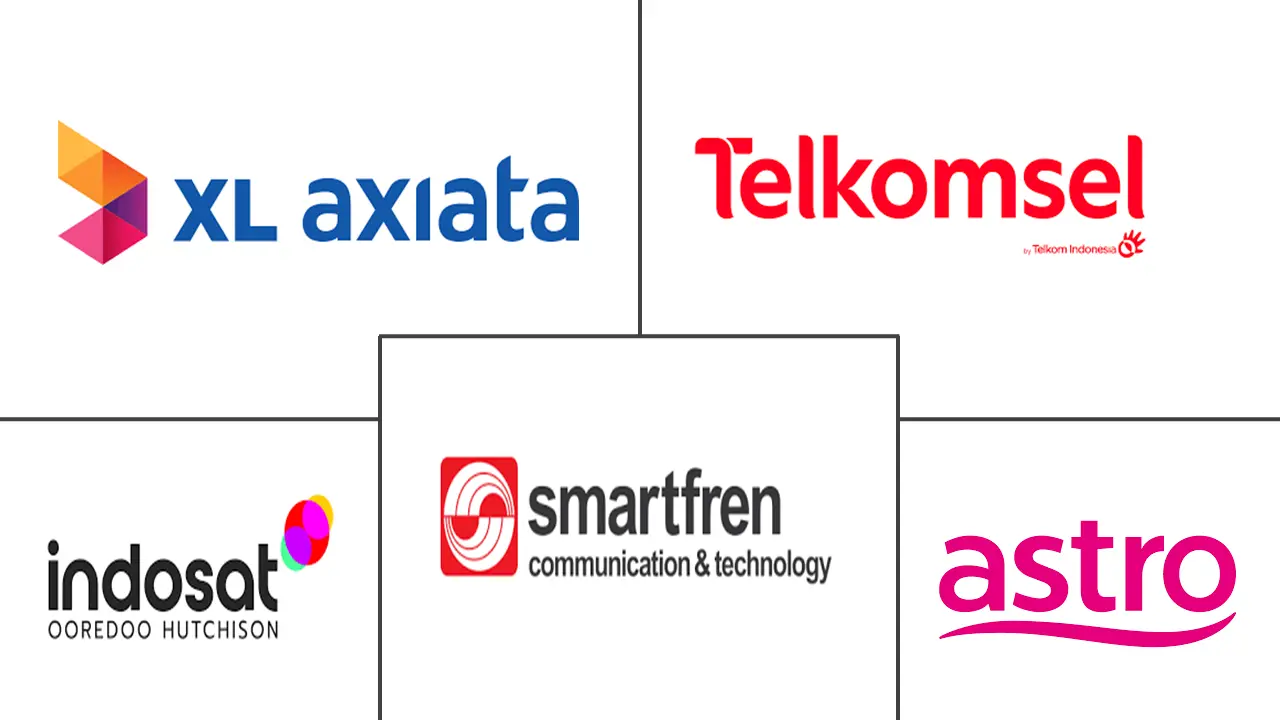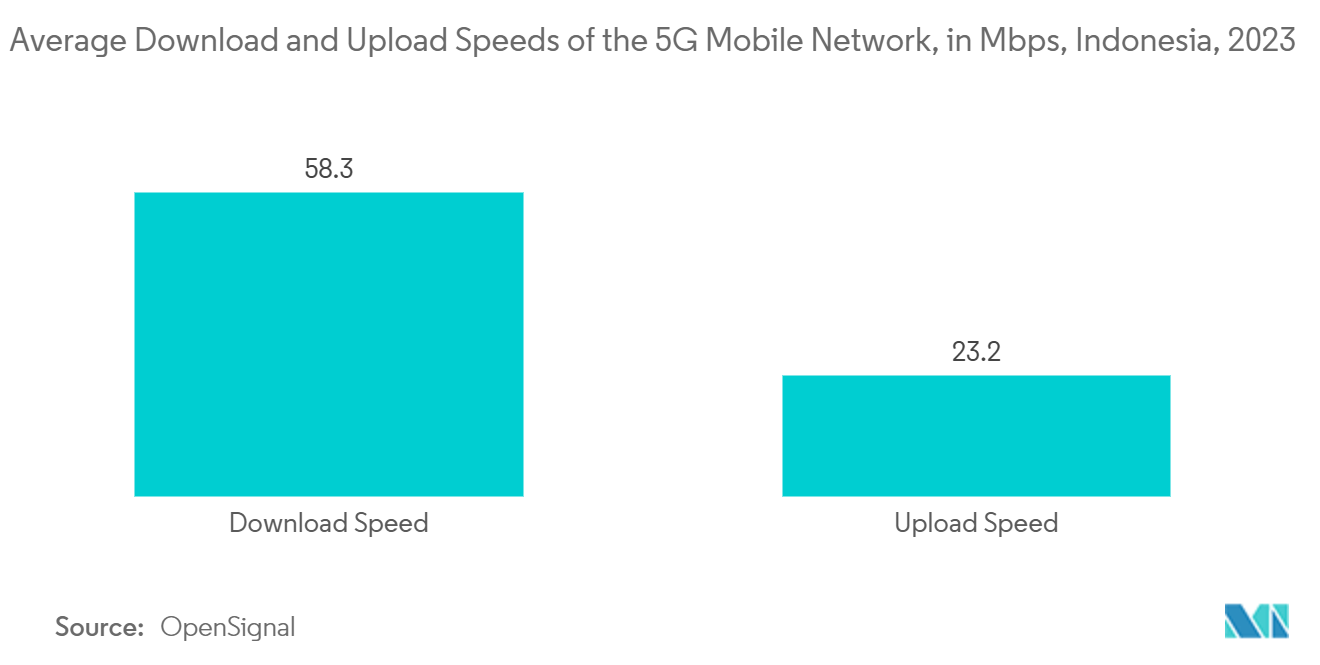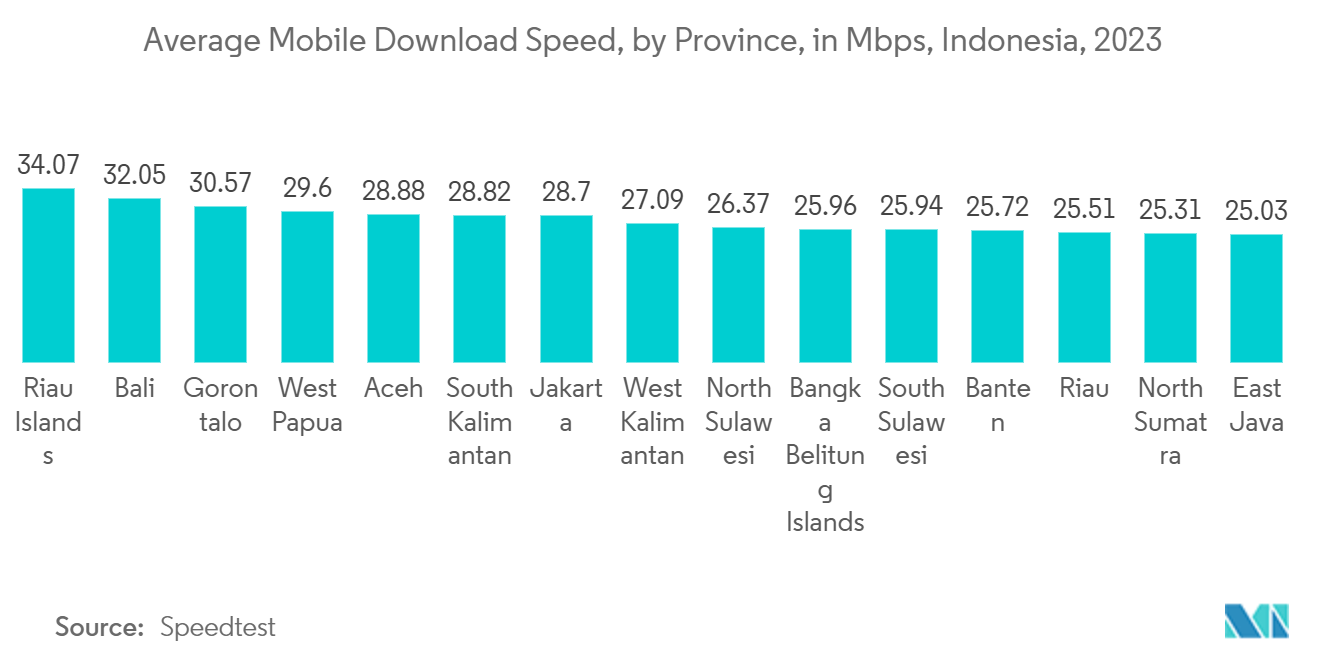Indonesia Telecom Market Size

| Study Period | 2019 - 2030 |
| Base Year For Estimation | 2024 |
| Forecast Data Period | 2025 - 2030 |
| Market Size (2025) | USD 18.12 Billion |
| Market Size (2030) | USD 23.97 Billion |
| CAGR (2025 - 2030) | 5.76 % |
| Market Concentration | Low |
Major Players
*Disclaimer: Major Players sorted in no particular order |
Indonesia Telecom Market Analysis
The Indonesia Telecom Market size is estimated at USD 18.12 billion in 2025, and is expected to reach USD 23.97 billion by 2030, at a CAGR of 5.76% during the forecast period (2025-2030).
The telecom market in Indonesia, which is among the biggest in the world, has plenty of opportunities to expand. This growth has been mainly caused by a possible increase in users. However, it may also be fueled by more revenue per user as the nation's earnings rise.
- The growing demand for high-speed connectivity services by customers and increasing spending on the deployment of 5G infrastructure positively influence the growth of the Indonesian telecom market. With the nation's steady transition into the digital age, the industry has been poised for consistent expansion. By January 2023, GSMA Intelligence reported that the number of cellular mobile connections in Indonesia had reached approximately 354 million, highlighting the extensive penetration of mobile technology within the country.
- Indonesia, with its vast territory and large population, presents both opportunities and challenges for the telecommunications industry. Responding to this dynamic landscape, the number of telecommunications providers in the country has increased. According to the Ministry of Communication and Technology, in 2023. This growth is closely tied to the government's policies promoting free competition and openness in telecommunications investments, particularly in cellular services.
- Furthermore, in June 2024, PT Telkom Indonesia, in collaboration with SingTel and Medco Power Indonesia, announced plans for a substantial investment. The collaboration aimed to inject IDR 1.4 trillion (about USD 85 million) into the construction of an advanced data center in Batam. This facility was intended to be equipped with Artificial Intelligence (AI) infrastructure, with the project scheduled for completion over a five-year period.
- Telkomsel has been granted a 5G bandwidth of 30 MHz, while Indosat allocated 20 MHz. These allocations are less than the recommended spectrum for an optimal 5G deployment. According to GSMA, an initial allotment of 80-100 MHz for the mid-band was suggested to ensure a robust spectrum. It was noted that more smartphone models were compatible with Indosat's 1.8 GHz band compared to Telkomsel's 2.3 GHz. Given Indosat's focus on the 1.8 GHz band and its initial emphasis on the B2B sector, the demand for smartphones supporting this band is expected to rise, albeit at a moderate pace.
- Moreover, recent projections indicated that the total mobile network data traffic was expected to exceed 370 EB by the end of 2027. By the end of 2021, the 88 million registered FWA connections were projected to surpass 230 million by 2027. It is anticipated that approximately half of these connections will utilize 5G networks.
- However, digital disruptions posed significant challenges to the growth trajectory of Indonesia's telecommunications industry. As consumer demands for faster and more reliable connectivity evolved alongside technological advancements, telecommunications operators were compelled to increase infrastructure, IT, and talent investments. Furthermore, the industry's substantial IT overhaul required significant capital expenditure (CAPEX) and involved extended lead times, further impeding market growth.
Indonesia Telecom Market Trends
Increased Pace of 5G Roll-out Driving the Market
- According to the Telecom Review Report, the government has been actively developing various spectrum bands to support the 5G network. This includes farming and refarming the frequency spectrum across different bands, ranging from low to super high.
- In November 2023, industry stakeholders convened at Solo Techno Park, Indonesia's first 5G park, for the 5G Ecosystems Acceleration Summit. This summit aligned with Indonesia's Digital Vision for 2030 and 2045, provided detailed insights into emerging business trends and elucidated the challenges and opportunities associated with deploying 5G solutions for consumers, homes, and businesses.
- The government is using its internet infrastructure to enhance its digital economy. In December 2023, Virtual Internet, a 5G software provider, partnered with PT. ABC to deploy its Virtual 5G technology across Indonesia. This agreement permitted PT. ABC to distribute an unlimited number of Virtual 5G applications. If fully utilized, this could result in up to 500 million licenses, each with an average annual subscription cost of USD 4.
- As per the Ericsson Mobility Report, telecom companies benefited significantly from offering 5G solutions to industries such as manufacturing, energy, utilities, and media. The report suggested that Indonesian telecom firms could have seen a 35% increase in income, amounting to USD 8.2 billion by 2030, by focusing on business-to-business (B2B) 5G services, despite the challenges in implementing 5G technology in the country. Furthermore, Bali had become the sixth city to receive 5G coverage, following Surakarta, Jakarta, Surabaya, Makassar, and Balikpapan.

Higher Demand for OTT Services Driving the Market
- Over-the-top (OTT) services, including streaming video, Voice over Internet Protocol (VoIP), and messaging applications, have gained significant popularity in Indonesia. Telecom operators adapted to this trend by offering bundled services, partnering with OTT providers, or developing their own OTT offerings to remain competitive in the market.
- In May 2024, Vidio, a streaming platform based in Indonesia and owned by the local conglomerate Emtek Group, announced plans to increase its number of paid subscribers to 8 million within the next two to three years. This target would have approximately doubled its subscriber base, which was 4.1 million as of 2023.
- Furthermore, in May 2024, ZTE Corporation, a global provider of integrated information and communication technology solutions, and MyRepublic, an internet service provider, announced the launch of Indonesia's first Wi-Fi 7 product at ZTE Day 2024. This event marked a significant collaboration between ZTE and MyRepublic, highlighting their dedication to advancing technological innovation and facilitating the commercial implementation of Wi-Fi 7. By introducing the Wi-Fi 7 CPE, MyRepublic aimed to provide users with a network experience that offered unprecedented high speeds and low latency.
- According to a Future of TV analysis by The Trade Desk, OTT streaming experienced a meteoric rise in popularity after the COVID-19 pandemic. Over one in three Indonesians already streamed material over the top (OTT) as OTT became a popular form of entertainment where people could watch their favorite shows across devices whenever and wherever they wanted. Indonesia led in the Southeast Asian region with a strong 40% Y-o-Y rise in OTT consumption.
- Smartphone costs decreased, mobile broadband coverage improved, and internet access became more reasonably priced. The expansion of OTT in Indonesia was linked to these trends. OTT platforms adjusted their offers to attract these customers by considering consumer preferences. More local and Asian content was available on the top three platforms than on any other platform in Indonesia's Play Store entertainment category. A weekly payment option was available in Vidio's subscription configuration for its sports broadcasting service.

Indonesia Telecom Industry Overview
The Indonesian telecom market is highly fragmented in nature. Some major players in the market studied are PT XL Axiata Tbk, PT Telekomunikasi Selular (Telkomsel), PT Indosat Tbk(IndosatOoredoo Hutchison), PT SmartfrenTelecom Tbk (SinarmasBusiness Group), Astro Indonesia Holdings SdnBhds, and fixed-line service providers. Some Indonesian telecommunication companies are competitive internationally and hold strong ground in the global telecom space.
Telecom operators face mounting pressure to maintain low prices, heightening the competitive rivalry. With most carriers providing akin services, opportunities for differentiation in telecom are constrained.
However, high barriers to exit due to high capital investments and costly network equipment might force a company to continue competing in the market, intensifying competition.
Indonesia Telecom Market Leaders
-
PT XL Axiata Tbk
-
PT Telekomunikasi Selular (Telkomsel)
-
PT Indosat Tbk(IndosatOoredoo Hutchison)
-
PT SmartfrenTelecom Tbk (SinarmasBusiness Group)
-
Astro Indonesia Holdings SdnBhd
*Disclaimer: Major Players sorted in no particular order

Indonesia Telecom Market News
- October 2024: Ericsson has unveiled the ‘Ericsson Hackathon 2024’ to drive digital transformation in Indonesia, leveraging Generative Artificial Intelligence (Gen AI) and 5G technology. This initiative is a joint venture with the Ministry of Industry, PIDI 4.0, Ministry of Communication and Digital, Innovation & Learning Centers, Swiss German University, and KORIKA. The hackathon will stimulate innovation and collaboration, further propelling the telecom market in Indonesia.
- January 2024: Aviat Networks, Inc., a player in wireless transport and access solutions, has entered into a strategic collaboration with PT Smartfren Telecom Tbk. This partnership aims to provide high-speed, ultra-reliable wireless connectivity, both indoor and outdoor private wireless networks, and services for digitalization and automation to private network customers throughout Indonesia. The collaboration seeks to capitalize on market opportunities, bolster competitive positioning, and enhance service to Indonesian clients. This will be achieved through pre-sales and solution engineering, joint sales efforts, market opportunity development, and unified customer service and support. Following its acquisition of NEC's Wireless Transport Business, Aviat has emerged as the wireless transport provider in Indonesia, boasting a wide-ranging portfolio of solutions and a robust local presence.
Indonesia Telecom Market Report - Table of Contents
1. INTRODUCTION
1.1 Study Assumptions and Market Definition
1.2 Scope of the Study
2. RESEARCH METHODOLOGY
3. EXECUTIVE SUMMARY
4. MARKET INSIGHTS
4.1 Market Overview
4.2 Industry Ecosystem Analysis
4.3 Industry Attractiveness - Porter's Five Forces Analysis
4.3.1 Bargaining Power of Suppliers
4.3.2 Bargaining Power of Consumers
4.3.3 Threat of New Entrants
4.3.4 Threat of Substitute Products
4.3.5 Intensity of Competitive Rivalry
4.4 Impact of Macroeconomic Trends on the Market
4.5 Regulatory Landscape in Indonesia
5. MARKET DYNAMICS
5.1 Market Drivers
5.1.1 Increased Pace of 5G Roll Out
5.1.2 Digital Transformation Boosting Telecom
5.1.3 Surge in demand for wireless broadband services
5.2 Market Restraints
5.2.1 Security Related Challenges
5.3 Analysis of the Market based on Connectivity (Coverage to Include In-depth Trend Analysis)
5.3.1 Fixed Connections
5.3.1.1 Broadband (Cable Modem, Wireline-fiber, Wireline DSL, Fixed Wi-Fi and Trends Regarding ADSL/VDSL, FTTP/B, Cable Modem, FWA, and 5G FWA)
5.3.1.2 Telephone
5.3.1.3 Median Upload and Download Speed for fixed broadband
5.3.2 Mobile Connections
5.3.2.1 Smartphone and Mobile Penetration
5.3.2.2 Mobile Broadband
5.3.2.3 2G, 3G, 4G, and 5G Connections
5.3.2.4 Median Upload and Download Speed for mobile connectivity
5.4 Details on Total Number of Telecom Towers in Indonesia along with List of Major Vendors
6. MARKET SEGMENTATION
6.1 Market Estimates and Forecast (2022-2029) for the Overall Telecom Market
6.2 Includes Telecom Subscriptions and Average Revenue Per User (ARPU)
6.3 Market Estimates and Forecasts Segmented By Services Type
6.3.1 Voice Services
6.3.2 Data and Messaging Services
6.3.3 OTT and PayTV Services
7. COMPETITIVE LANDSCAPE
7.1 Revenue Market Share Analysis of Key Vendors
7.2 Coverage on Telkomsel, XL Axiata, Indosat, etc.
7.3 Company Profiles
7.3.1 PT XL Axiata Tbk
7.3.2 PT Telekomunikasi Selular (Telkomsel)
7.3.3 PT Indosat Tbk(IndosatOoredoo Hutchison)
7.3.4 PT SmartfrenTelecom Tbk (SinarmasBusiness Group)
7.3.5 Astro Indonesia Holdings SdnBhd
7.3.6 PT Sampoerna Telekomunikasi Indonesia (STI)
7.3.7 PT Elang MahkotaTeknologi Tbk(Emtek)
7.3.8 PT Infrastruktur Digital Indonesia
7.3.9 PT IndonusaTelemedia
7.3.10 PT First Media Tbk
7.3.11 PT Net Satu Indonesia (Net1)
- *List Not Exhaustive
8. INVESTMENT ANALYSIS
9. MARKET OPPORTUNITIES AND FUTURE TRENDS
Indonesia Telecom Industry Overview
Telecommunications, or telecom, refers to the transmission of information over long distances using electromagnetic signals. The study on the Indonesian telecom market includes a detailed analysis of connectivity trends, focusing on fixed networks, mobile networks, and telecom towers.
Telecom services is segmented into (voice services, data and messaging services, over-the-top (OTT) services, and Pay TV services).
The study also examines the impact of macroeconomic trends on the market and impacted segments. The study also discusses the drivers and restraints likely to influence the market's evolution in the near future. The market sizes and forecasts are provided in terms of value (USD) for all the above segments.
| Market Estimates and Forecasts Segmented By Services Type | |
| Voice Services | |
| Data and Messaging Services | |
| OTT and PayTV Services |
Indonesia Telecom Market Research Faqs
How big is the Indonesia Telecom Market?
The Indonesia Telecom Market size is expected to reach USD 18.12 billion in 2025 and grow at a CAGR of 5.76% to reach USD 23.97 billion by 2030.
What is the current Indonesia Telecom Market size?
In 2025, the Indonesia Telecom Market size is expected to reach USD 18.12 billion.
Who are the key players in Indonesia Telecom Market?
PT XL Axiata Tbk, PT Telekomunikasi Selular (Telkomsel), PT Indosat Tbk(IndosatOoredoo Hutchison), PT SmartfrenTelecom Tbk (SinarmasBusiness Group) and Astro Indonesia Holdings SdnBhd are the major companies operating in the Indonesia Telecom Market.
What years does this Indonesia Telecom Market cover, and what was the market size in 2024?
In 2024, the Indonesia Telecom Market size was estimated at USD 17.08 billion. The report covers the Indonesia Telecom Market historical market size for years: 2019, 2020, 2021, 2022, 2023 and 2024. The report also forecasts the Indonesia Telecom Market size for years: 2025, 2026, 2027, 2028, 2029 and 2030.
Indonesia Telecom Industry Report
The Telecom Industry in Indonesia is witnessing robust growth, fueled by technological advancements and a surge in digital service demand. The rollout of 5G networks and increased mobile data usage are propelling market expansion, further boosted by the rise of Internet of Things (IoT) devices and the swift pace of digital transformation. This growth is supported by the growing trend of remote work, the affordability of smartphones, and the focus on enhancing connectivity, making telecommunications essential for daily life and economic activities. Market segmentation highlights services like voice, data, messaging, Over-the-Top (OTT), and pay-TV, aiming to improve reach across urban and rural areas. The competitive landscape thrives on innovation and service quality enhancement, meeting the rising consumer demand for a resilient telecom infrastructure. According to Mordor Intelligence™ Industry Reports, the Telecom in Indonesia market is analyzed for share, size, revenue growth rate, with forecasts and historical overviews available. This analysis underscores the sector's promising future, driven by consumer needs and technological advancements. Get a glimpse of this dynamic market through a free report PDF download, offering insights into the telecom industry's growth trajectory in Indonesia.



